In the past two decades, the Internet in Bangladesh has gotten out from under the shadow of its earlier dependence on costly satellite links for connectivity, growing from 0.1% to over 75% penetration. But the real work lies ahead: strengthening local peering, reaching rural areas, and building infrastructure that serves everyone.
Today, with over 130 million Internet users across the country, Bangladesh stands at the forefront of South Asia’s digital revolution. As the country moves from incremental progress to ambitious innovation, its expanding digital infrastructure promises not only faster connectivity, but new opportunities for inclusive growth and future resilience.
Challenges
Despite significant progress, Bangladesh continues to face several hurdles in building a robust Internet ecosystem. Let us look at some of the main challenges in turn.
- International connectivity: Before 2005, Bangladesh depended on costly satellite links, which limited both bandwidth and affordability. While undersea cables have improved global access, ensuring diverse and reliable international connectivity remains a top priority as demand surges.
- Local peering: Although Internet Exchange Points (IXPs) such as BDIX and ISPAB-NIX exist, only around 7.6% of networks peer locally. As a result, much of Bangladesh's internal traffic still routes through international links, increasing both latency and costs.
- Last-mile access: In villages outside Dhaka, network engineers still face logistical hurdles when deploying fiber. Laying fiber to every village is costly and challenging, leaving many rural communities undeserved despite ongoing local broadband initiatives and infrastructure efforts.
- IPv6 transition: While the shift to IPv6 has begun, the majority of networks and devices remain on legacy IPv4. This slows innovation and future-proofs Bangladesh's Internet less effectively, since IPv6 supports a vastly larger address space and enhances security.
- Routing security: About 98% of Bangladesh’s IP address space now has RPKI Route Origin Authorisations (ROAs), which help prevent route hijacking and misconfigurations. However, few providers enforce strict filtering to drop invalid routes, leaving vulnerabilities in the routing system that could impact both local and global traffic.
Solutions and progress
Undersea cables
The landing of the SEA-ME-WE-4 cable in 2005 marked a transformational moment for Bangladesh's international connectivity. Since then, the addition of SEA-ME-WE-5 in 2016 and the planned SEA-ME-WE-6 in 2026 have further boosted capacity and ensured redundancy. Today, four licensed operators provide submarine cable services, increasing both competition and resilience for the country's Internet infrastructure, as shown in Figure 1.
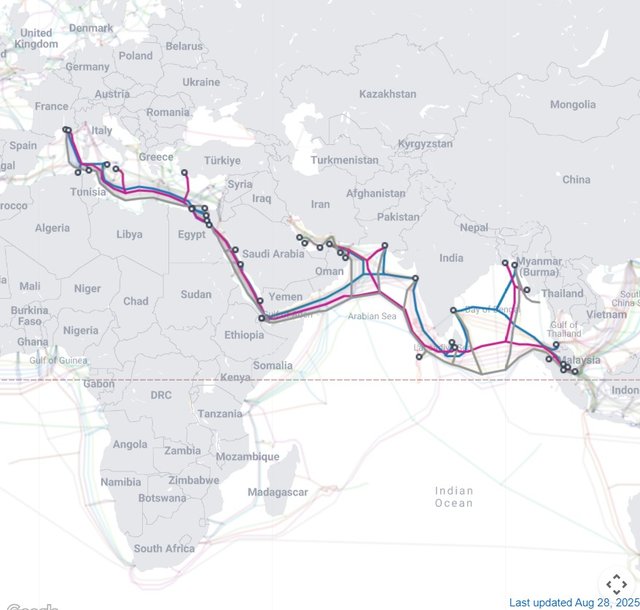
IXP expansion
The number and capacity of Internet Exchange Points (IXPs) are growing rapidly. BDIX, the largest IXP, began operating in Dhaka in 2004, and new IXPs are now expanding to other cities. Bangladesh's IXP growth is keeping pace with regional leaders, helping retain local traffic within the country, reduce latency, and lower international bandwidth costs.
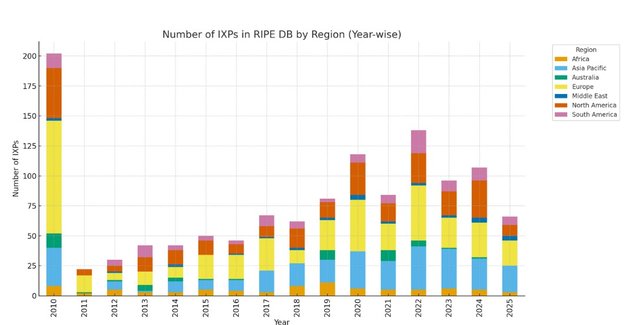
Promoting IPv6
By March 2025, about 18.3% of user connections in Bangladesh were IPv6-capable - a dramatic rise from previous years. Figure 3 shows how Bangladesh’s technical community has rapidly embraced IPv6, turning a near-zero adoption rate into a success story.
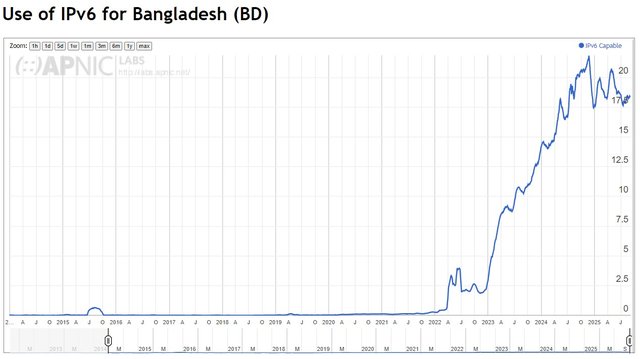
Strengthening routing security
Bangladesh has made significant progress in routing security, with about 98% of IP address space now covered by RPKI Route Origin Authorisations (ROAs). However, the lack of strict invalid route filtering means some vulnerabilities persist, as detailed in Figure 4. Ongoing efforts are focused on encouraging more providers to implement robust filtering practices to protect both local and global traffic.
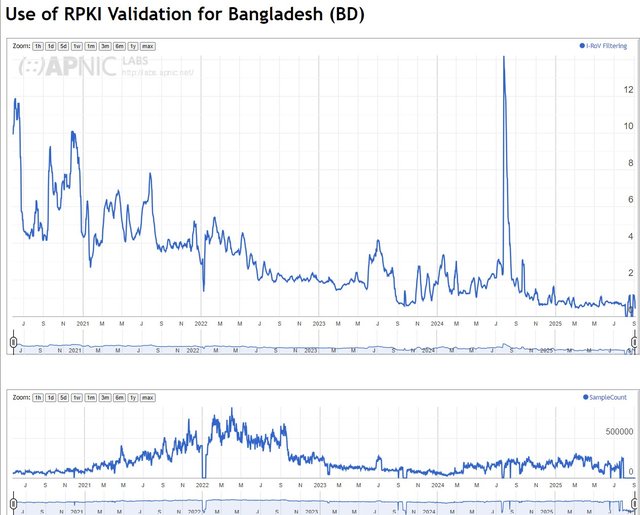
Future outlook
Bangladesh's Internet infrastructure stands at a critical juncture. The foundation built over the past two decades - from the transformative arrival of submarine cables to the steady growth of local peering and IPv6 adoption - has positioned the country as a regional digital leader. However, the next phase of development will require even greater coordination, investment, and technical expertise.
Continued investment in undersea cables, local peering, rural connectivity, IPv6 deployment, and routing security will be essential for building a resilient digital future. While new technologies such as satellite broadband solutions (including Starlink) promise to reach the most remote areas, ongoing risks remain - such as dependency on a limited number of submarine cables and the need for robust policy frameworks.
Community engagement is strong, with local NOG events and APNIC conferences fostering innovation and knowledge sharing. To truly secure its digital future, Bangladesh must build on its successes - while remaining vigilant against new risks like cable dependency and evolving cyber threats.
Conclusion: A call to action for the global Internet community
Bangladesh's digital transformation represents more than statistical achievements - it embodies the potential for technology to drive inclusive economic growth and social development. From connecting 130 million users to establishing robust peering infrastructure, Bangladesh has demonstrated that developing nations can rapidly build world-class Internet ecosystems with the right combination of policy support, private investment, and technical expertise.
However, significant challenges remain. The rural-urban digital divide, illustrated clearly in our connectivity analysis, requires innovative solutions that go beyond traditional infrastructure deployment. The low local peering rates - despite substantial IXP growth - indicate that more work is needed to optimise traffic flows and reduce dependency on international links. Most critically, while Bangladesh has achieved impressive RPKI ROA coverage, the lack of widespread invalid route filtering exposes vulnerabilities that could impact both national and regional Internet stability.
For RIPE and the broader Network Operator Group (NOG) community, Bangladesh's experience offers both inspiration and opportunity. The country's rapid IPv6 adoption - reaching 18.3% user penetration - demonstrates that accelerated protocol transitions are possible with coordinated effort between ISPs, regulators, and technical communities. Similarly, the success of BDIX and regional IXPs shows how local peering can flourish when supported by proper policy frameworks and industry collaboration.
Moving forward, the global Internet community can support Bangladesh's continued growth through several concrete actions:
- Share best practices for rural connectivity solutions, particularly low-cost fiber deployment and wireless access technologies
- Provide technical training and capacity building for IPv6 implementation and routing security practices
- Support the development of additional regional IXPs to improve traffic localisation and reduce international transit costs
- Collaborate on submarine cable diversity initiatives to enhance resilience against single points of failure
- Assist in developing local Internet governance frameworks that balance innovation with security and stability
Bangladesh's journey from satellite dependency to submarine cable connectivity, from isolated networks to thriving IXPs, and from IPv4-only to dual-stack operations, illustrates the transformative power of collaborative technical development. As the country continues to build its digital infrastructure, the lessons learned and challenges faced offer valuable insights for the entire South Asian region and beyond.
The foundation for a faster, safer, and more accessible Internet in Bangladesh will continue to strengthen through partnerships between local operators, international organisations like the RIPE NCC and APNIC, and the global technical community. Together, we can ensure that Bangladesh's digital success story becomes a model for sustainable, secure, and inclusive Internet development worldwide.
Acknowledgments
The authors acknowledge the valuable contributions of the Bangladesh Internet community, including network operators, Internet Service Providers, and technical organisations who provided data and insights for this analysis. Special recognition goes to the teams at BDIX, APNIC Labs, and BTRC for their ongoing measurement and reporting efforts that make comprehensive analysis possible.

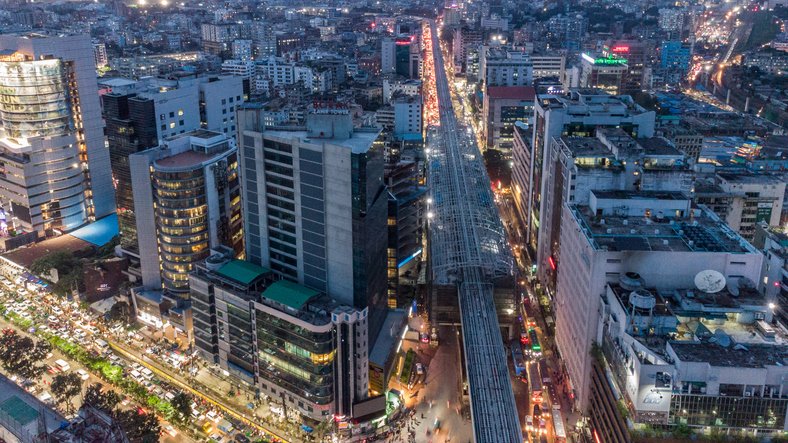
Comments 1
rabbi •
Great analysis! do you think a hybrid fiber-wireless approach could be a sustainable solution for Bangladesh?”